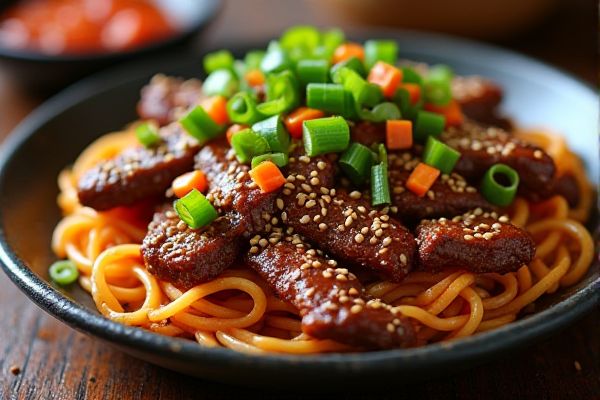
Korean Spicy Beef from Pei Wei features tender strips of marinated beef sauteed with vibrant garlic, ginger, and fresh scallions, tossed in a bold gochujang-based sauce, and garnished with sesame seeds, delivering a flavorful, spicy, and savory Korean-inspired dish.
Equipments
- Wok
- Chef's knife
- Cutting board
- Mixing bowls
- Tongs
- Measuring spoons
- Measuring cups
- Whisk
- Spatula
- Plate or serving dish
Ingredients
- 1 lb (450g) beef sirloin or flank steak
- 2 tablespoons soy sauce
- 1 tablespoon gochujang (Korean chili paste)
- 1 tablespoon brown sugar
- 1 tablespoon rice vinegar
- 1 tablespoon sesame oil
- 2 teaspoons cornstarch
- 1 tablespoon vegetable oil
- 4 cloves garlic
- 1 tablespoon minced ginger
- 4 scallions
- 1 tablespoon toasted sesame seeds
Soy sauce and gochujang are key to achieving the authentic Korean flavor in this dish, so using high-quality versions will enhance the taste. Fresh garlic, ginger, and scallions provide the vibrant aromatics that balance the boldness of the sauce. When choosing beef, sirloin or flank steak offers the best tenderness and flavor for sauteing. Toasted sesame seeds add a nutty finish and a subtle crunch, so don't skip this garnish. You can recreate the bold and savory flavors of Korean Spicy Beef from Pei Wei at home by carefully selecting these ingredients and following the recipe.
Instructions
- Slice beef thinly against the grain.
- In a mixing bowl, combine soy sauce, gochujang, brown sugar, rice vinegar, sesame oil, and cornstarch; whisk well.
- Add sliced beef to marinade; toss to coat. Let marinate for 20-30 minutes.
- Mince garlic and ginger. Slice scallions (separate white and green parts).
- Heat wok over high heat; add vegetable oil.
- Add marinated beef to wok; stir-fry until browned, 2-3 minutes. Remove beef, set aside.
- Add garlic, ginger, and white parts of scallions to wok; stir-fry until fragrant, about 30 seconds.
- Return beef to wok; toss to combine with aromatics.
- Cook until beef is cooked through and sauce thickens, 1-2 minutes.
- Transfer to plate or serving dish.
- Garnish with green parts of scallions and toasted sesame seeds.
- Serve immediately.
Substitution
Korean Spicy Beef from Pei Wei copycat features a rich gochujang-based sauce that imparts its signature heat and depth of flavor. If gochujang is unavailable, you can substitute with a blend of chili paste mixed with a touch of miso or soy sauce to mimic its complexity. When choosing beef, flank steak offers a lean, tender texture, but sirloin can be used as a more widely available alternative without sacrificing taste. Rice vinegar adds a mild tang that brightens the sauce, though white wine vinegar can work if you lack it. Your use of a wok helps achieve quick, high-heat cooking, essential for locking in flavors and keeping the beef tender.
Tips
Maintain a high heat on your wok to quickly sear the thinly sliced beef, locking in juices and achieving a tender texture without overcooking. Slice beef against the grain to ensure each bite is tender and easy to chew. Whisk the marinade thoroughly so the cornstarch evenly thickens the sauce during cooking, preventing clumps or a runny consistency. You should marinate the beef for at least 20 minutes to fully absorb the bold flavors of gochujang, soy sauce, and aromatics for a balanced spicy and savory dish.
Nutritions
Korean Spicy Beef offers a rich source of protein from tender sirloin or flank steak, essential for muscle maintenance and repair. The gochujang-based sauce not only provides a bold flavor but also contains capsaicin, which can help boost metabolism. Fresh garlic, ginger, and scallions contribute antioxidants and anti-inflammatory compounds supporting overall health. By preparing this dish yourself, you can control sodium and sugar levels, tailoring it to suit your dietary needs.
Storage
Store leftover Korean Spicy Beef in an airtight container to maintain freshness and prevent moisture loss. Refrigerate your dish promptly and consume within 3 to 4 days for optimal taste and safety. When reheating, use a microwave or stovetop to warm evenly without drying out the tender beef strips.
Variation or Alternatives
You can substitute beef sirloin with thinly sliced chicken breast or tofu to create a lighter or vegetarian version of this Korean spicy dish. For a smoky flavor twist, try adding a teaspoon of smoked paprika or a dash of liquid smoke to the marinade. Instead of stir-frying in a wok, you can broil the marinated beef strips in the oven for a slightly charred texture. Adjust the heat level by reducing gochujang or adding honey if you prefer a milder, sweeter profile.
Allergies
Your Korean Spicy Beef may pose allergy risks related to soy, sesame, and gluten. Soy sauce, a key ingredient, commonly contains soy and wheat, which can trigger allergic reactions or sensitivity. Sesame seeds and sesame oil are common allergens that should be avoided if you have a sesame allergy.
Why this recipe?
Korean Spicy Beef at Pei Wei restaurant captivates diners with its bold blend of gochujang, garlic, and soy sauce, delivering an authentic spicy-sweet flavor profile. Tender slices of beef are perfectly marinated and stir-fried with fresh vegetables, creating a harmonious balance of taste and texture that satisfies cravings for Korean cuisine. Your attempt to make this copycat recipe replicates the vibrant, restaurant-quality flavors at home, offering a cost-effective and customizable dining experience. The dish's popularity stems from its dynamic spice level and savory depth, making it a rewarding challenge to master in your own kitchen.
